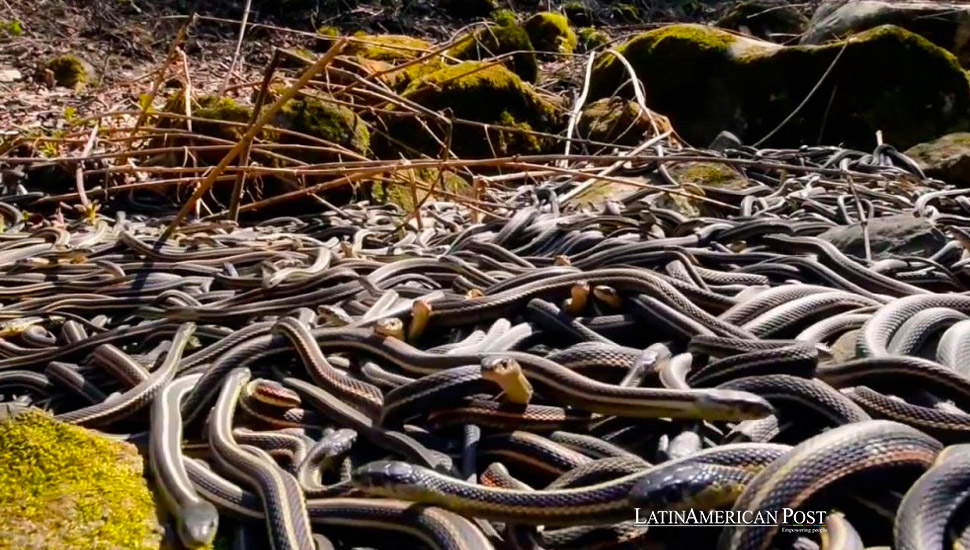The Deadly and Terrifying Beauty of Brazil’s Ilha da Queimada Grande

Ilha da Queimada Grande, or Snake Island, is infamous for its dense population of golden lancehead vipers, one of the deadliest snakes on Earth. Isolated for millennia, this Brazilian island harbors a fascinating yet terrifying ecosystem that remains off-limits to most, fueling legends and scientific intrigue.
Ilha da Queimada Grande, known to many as Snake Island, sits approximately 33 kilometers off the coast of Brazil. While Brazil is home to many breathtaking natural wonders, this island presents a more sinister allure. To the untrained eye, it may seem like just another picturesque rock formation in the Atlantic Ocean. However, hidden within its 43 hectares is one of nature’s most formidable inhabitants: the golden lancehead viper, Bothrops insularis.
The origins of this fearsome predator date back approximately 11,000 years. As sea levels rose at the end of the last ice age, Ilha da Queimada Grande became isolated from mainland Brazil, stranding its resident snake population. The snakes marooned here—likely ancestors of the jararaca snake—were forced to adapt to their new environment. These snakes faced unique evolutionary pressures without natural predators or typical ground-level prey. Over millennia, they evolved into a species distinct from their mainland relatives.
The golden lancehead viper is unique in its evolution and hunting strategy. With no ground-level prey to hunt, these snakes adapted to survive by preying on migratory birds that visit the island seasonally. Unlike snakes that strike and follow their prey, the golden lancehead evolved incredibly potent venom to compensate for its inability to track down birds once bitten. This venom, up to five times stronger than mainland snakes, can kill prey almost instantaneously—an adaptation crucial for survival on this isolated island. Unfortunately for humans, this venom is just as effective on our kind, with the potential to melt flesh and cause severe organ damage, leading to death within an hour without prompt treatment.
The True Danger of the Golden Lancehead
Ilha da Queimada Grande has long been the subject of fascination and fear, its reputation shrouded in local lore and terrifying tales. Stories abound of the island’s deadly inhabitants, from the unfortunate fisherman who landed in search of bananas only to be found days later in his boat, dead from snake bites, to the lighthouse keeper and his family who, according to legend, met their end when snakes slithered through their windows in the night.
Some legends even suggest that the island’s snake population was deliberately introduced by pirates hoping to protect their buried treasure. However, scientific evidence debunks this myth, pointing instead to natural processes that led to the island’s isolation and subsequent snake proliferation.
Despite the terrifying tales, the reality of the golden lancehead’s danger to humans is somewhat less dramatic. While the venom of these vipers is undoubtedly deadly, human interaction with them is exceedingly rare. The Brazilian government strictly controls access to the island, allowing only scientists and a few other authorized personnel to visit. Even then, a doctor must accompany any expeditions to ensure immediate treatment in the unlikely event of a snake bite.
Curiously, despite the golden lancehead’s fearsome reputation, documented cases of human fatalities caused by these snakes are virtually nonexistent. Biologists who have studied the vipers say these snakes are non-aggressive and generally do not strike unless provoked. Moreover, their venom is specifically evolved to target birds, not mammals, which raises questions about the risk they pose to humans.
The golden lanceheads primarily feed on two species of migratory songbirds: the Chilean elaenia, which visits the island in spring, and the yellow-legged thrush, which arrives in autumn. Interestingly, the island’s two resident bird species—the southern house wren and the bananaquit—seem to have developed strategies to avoid becoming prey, further highlighting the intricate balance of this isolated ecosystem.
The Threats Facing a Unique Species
Ilha da Queimada Grande’s unique ecological environment, while fascinating, is also fragile. The golden lancehead viper, which once thrived in isolation, now faces significant threats to its survival. The population of these snakes has been dwindling in recent years, with estimates suggesting a decline of nearly 50 percent over the past 15 years.
One significant factor contributing to this decline is illegal wildlife trafficking. Due to its rarity and potent venom, the golden lancehead has become a prized biopirate target. These smugglers trap the snakes and sell them on the black market, where a single viper can fetch anywhere from $10,000 to $30,000. This illicit trade not only threatens the survival of the species but also disrupts the delicate ecological balance of the island.
In addition to poaching, habitat degradation poses another serious threat to the golden lancehead population. The Brazilian navy, which maintains an automated lighthouse on the island, has been responsible for removing vegetation, further reducing the already limited habitat available to the snakes. Disease has also been cited as a contributing factor to the population decline, making conservation efforts all the more urgent.
The golden lancehead is currently listed as critically endangered on the International Union for Conservation of Nature’s (IUCN) Red List, a stark reminder of the vulnerability of this unique species. While some might view the decline in snake numbers as a reduction in the island’s danger, it represents a significant loss of biodiversity. The golden lancehead, found nowhere else in the world, is a product of millions of years of evolution—its extinction would mean the loss of a species that has fascinated and frightened humans for generations.
The Forbidden Allure of Ilha da Queimada Grande
The danger the golden lanceheads pose and the island’s forbidden status has only heightened public curiosity about Ilha da Queimada Grande. Despite the risks, the island continues to attract attention from scientists, thrill-seekers, and the media.
In 2023, YouTuber Lord Miles gained notoriety when he evaded Brazilian authorities and landed on the island, documenting his experience for his followers. Clad in body armor to protect himself from potential snake bites, he roamed the island but failed to encounter a single viper during his brief visit. While his stunt captured headlines, it also underscored the rarity of snake sightings, suggesting that the population may be even lower than current estimates.
Lord Miles’s adventure, while reckless, speaks to a broader human fascination with danger and the unknown. Ilha da Queimada Grande, with its dense snake population and restricted access, embodies a mysterious allure that has captivated imaginations worldwide. Yet, for all the hype surrounding its deadly inhabitants, the reality of Snake Island is more complex.
For scientists, Ilha da Queimada Grande represents a valuable natural laboratory. The island’s isolated ecosystem provides insights into evolutionary processes and species adaptation. Researchers studying the golden lancehead hope to understand better the broader Bothrop genus, which includes other venomous snakes responsible for most snake bites in Brazil. Additionally, the medical potential of snake venom, including that of the golden lancehead, has become a significant area of interest. Venom has shown promise in treating heart disease, blood clots, and cancer, suggesting that the island’s notorious vipers could one day contribute to life-saving medical advancements.
While the public may be drawn to Snake Island for its reputation as a deadly, forbidden place, Ilha da Queimada Grande’s actual value lies in its role as a site of scientific discovery. As the global community becomes increasingly aware of the importance of preserving biodiversity, the fate of the golden lancehead and its isolated home is a stark reminder of the delicate balance between nature and human intervention.
Also read: Brazil’s Congress Challenges Presidential Veto on Indigenous Lands
In the end, Ilha da Queimada Grande is more than just a terrifying legend—it is a testament to the complexity and resilience of life, even in the most inhospitable places on Earth. As scientists continue to unlock the secrets of Snake Island, they are not only working to preserve a critically endangered species but also to expand our understanding of the natural world and its potential to inspire and heal.





